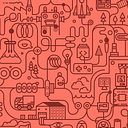My Version of the Future of Work
This is what the future of work looks like to me. This view of the future of work is imagined through the lens of employee productivity and engagement. My focus then is on how future employees will communicate, collaborate, and get things done.
Effortlessly Share Information
The future worker will be able to distribute information, both formally and informally, with ease. Sharing information will be seamless with their every day activities and workflow. Enterprise applications will have the same integration with consumer devices as consumer applications have today. The majority of enterprise software will have a social component built in, but they will no longer be restricted to only that application — updates and activity streams from separate applications will talk to each other without user intervention.
Effortlessly Consume Information
Corresponding to the increase in the ease of sharing information, the future worker will be able to consume information just as effortlessly. Relevant updates will flow in and out of the employee’s daily activities much like they already do today; however, the importance and urgency of the information will be more accurately weighed in the future thereby minimizing unnecessary interruptions and queuing lower priority updates up for a later time. This increase in our systems’ ability to judge the importance of information will be the biggest factor in enabling “effortless consumption.” Without it, the deluge of incoming information will be too much for an individual to handle.
Always On Communication
We already see this to a large degree today; however, in the future — right or wrong — the expectation that employees are always available will increase. The big caveat though is that employees will have some control on turning on or off the flow of notifications and communications. “Do not disturb” settings in communication software will become the norm and although communication will be instantaneous, it will at the same time remain asynchronous. Coupled with the increase in the ability for applications and systems to gauge priority, our technology will help the right messages get to the right people at the right time more so than ever before.
One Communication Point
Chat, long form, voice, and video will all originate from the same launch point. No more separate applications for email, instant messaging, chat or texts. No more multiple voicemail boxes that no one wants to check anyway. And no more one off video sharing applications that only a few handful of workers leverage. All communication will start and end from the same application.
Mobile Computing
This seems rather minor in the big scheme of things and perhaps even at this point in time it is irrelevant; however, the future worker will no longer need or be provided by default a desktop computing device. The future worker will be unchained from the need to sit at a specific desk. Everything they will need will be able to move with them and most of it will fit in their pocket. There will be exceptions, of course, where specialized jobs require specialized equipment. The majority of the workforce, however, will be capable of getting their jobs done with mobile devices alone. Even more so when they each have their own personal assistant.
Artificially Intelligent Assistants
We already live and work in a world that has a sizable amount of Artificial Narrow Intelligence (ANI) woven throughout it. ANI is AI that specializes in a single area, such as a music recommendation system, email spam filter, or a chess playing computer. Once Artificial General Intelligence (AGI) is achieved, our work (and personal) lives will forever be categorically changed. AGI is AI that is as smart as a human, but not just any human — the smartest humans. Think ANI but across the board. The best at many tasks. Okay, there is a lot to unpack in thinking about AGI and the implications to society and humanity. Let’s not go there. If you want to, go here for that.
AI Assistants in the workplace will enable ubiquitous, automated workflow of simple and semi-complex tasks integrated into daily activities both under the hood and out in the open. What’s that mean? It means these AI Assistants are going to do a ton of our work for us. I don’t think that AI is going to immediately take over everyone’s jobs and put us all out of work. Instead, every worker will have an assistant to help them get their jobs done in a way that allows them to focus on the most important and impactful tasks. These AI Assistants will be the drivers that enable the both information sharing and consumption. They will be the filters that direct the incoming flow of information and notifications. They will prioritize communications in a way that helps us do more in less time, focusing on what’s important and urgent, exactly when it is important and urgent. As a byproduct, less things will be urgent in the future because less things are going to fall through the cracks because these AI Assistants are on top of it.
The AI Supervisor
All of these little AI Assistants throughout the organization, each helping an individual worker do their best work, will also be connected in a way to ensure they are enabling the best work for the entire company. The AI Supervisor will be the overseer in charge of bringing it all together, brokering information exchange at enterprise scale. Not only will the AI Supervisor ensure that basic, tactical level interactions and information exchange occurs, it will be able to guide the entire company to focus on strategic objectives in a coordinated and integrated manner by prioritizing and elevating activities that align with and further the goals of the company. The AI Supervisor, then, is both intimately familiar with the mundane and minuscule tasks that keep the gears moving as well as completely aware of the big picture and how the company is moving toward achieving it’s vision and mission. The AI Supervisor will be an indispensable tool to the CEO, who will have more clarity into what is really going on than ever before.
How far out is the future of work? Is it tomorrow? Next month? A few years from now? Whenever it is, the truth is it probably won’t look much like I describe above and it probably won’t look much like anyone else is describing either. The future of work will creep up on us and slowly evolve from what we do today into what we do tomorrow. We won’t even notice it. We’ll still be talking about the future of work and how everything is going to change when everything has already changed right under our noses.

